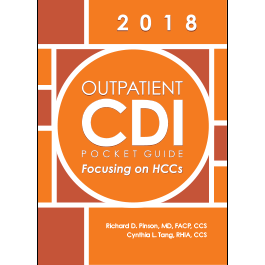Tip: Use technology and CMS guidance to improve HCC capture

HCC capture? Take a look
at the Outpatient CDI
Pocket Guide!
Many organizations have Hierarchical Condition Category (HCC) tools built into their CDI software or EHRs that can help them capture HCCs. When providers click on a diagnosis or a condition, the tool will mark whether the diagnosis is an HCC. Other technology can extract pharmacy data, lab data, other diagnoses, and the problem list, analyze the information, and then use it to suggest an HCC code.
While that may make it easier for the provider, James P. Fee, MD, CCS, CCDS, CEO of Enjoin, says the technology could also create problems. For example, the technology may look for open conditions and could pull codes that are no longer acute conditions, such as mistakenly capturing acute stroke from a code denoting history of acute stroke. However, capture of the ongoing sequela is important, he says.
“Some of these tools are good at looking at potential suspects, but it’s more important to have compliant capture. So we have to educate providers on what it means to report the condition and clinically support it in documentation,” he says.
He also suggests that if HIM directors look at HCC tools that give scores, they should do a secondary patient record review to ensure the accuracy.
In essence, Fee says, technology is most useful if it’s coupled with audits and education. “HCC capture, from an HIM perspective, is important because compliance is based on the coding index, guidelines, and Coding Clinics, but also evidence-based medicine. It all comes into play.”
Look to CMS for data, guidance
There currently isn’t federal data on HCC details and capture rates, but CMS is expected to release that information at some point to provide a better picture of what is happening across the industry. Although some Medicare Advantage companies and organizations may issue reports on the data they collect, Sonia Trepina, MPA, director of ambulatory CDI services at Enjoin CDI, cautions HIM directors to be aware that insurance companies, like health systems, could interpret guidelines differently in accordance with their own internal policies, therefore creating variances in data sets of HCC capture information.
“There is vagueness out there when it comes to risk adjustment, so the industry needs to be very clear on what gets counted toward an HCC versus what does not get counted and why,” she says.
Editor’s note: This article originally appeared in Revenue Cycle Advisor. To read an ACDIS Radio Recap (and listen to the accompanying episode) featuring Trepina, click here.
